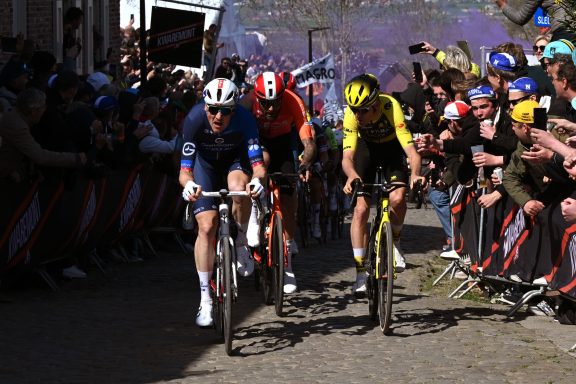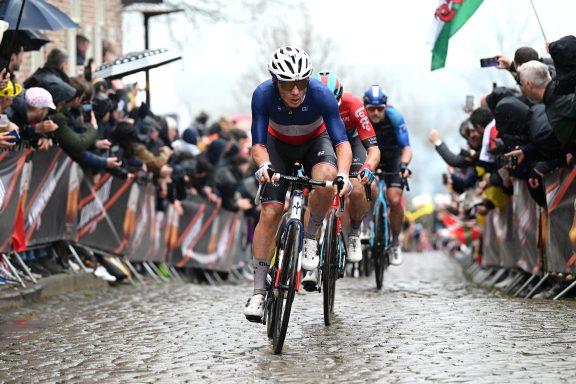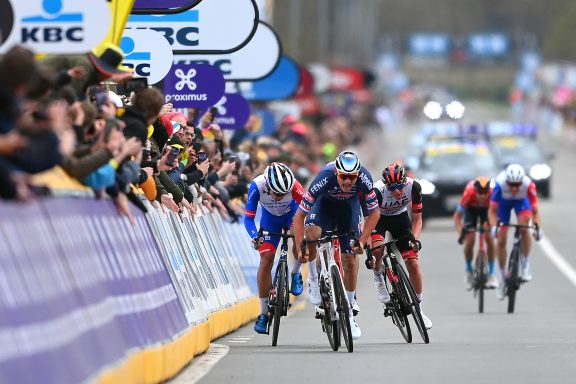The Tour of Flanders never does any favours, but on Sunday, it also gave almost no rest to the riders. Following an extremely lively first half of the race, the major moves indeed began more than one hundred kilometres from the finish. Stefan Küng immediately entered the fight and was thus able to take a step ahead. The Swiss rider stayed in front of the race until the last twenty-three kilometres, before the last Oude Kwaremont-Paterberg sequence. There, Tadej Pogacar flew away to victory as the Groupama-FDJ man fought hard in the back to secure sixth place in the fastest “Ronde” in history.
“Valentin immediately understood that he wouldn’t be able to be up there”, Frédéric Guesdon
The Belgian “holy” week was set to come to an end this Sunday with, as a high point, the second Monument of the season – for some the most beautiful event of the year -. Seven years later, the Tour of Flanders also returned to Bruges, the starting point of 273 kilometres featuring nineteen hills and six cobbled sections. One hundred kilometres preceded the very first climbs, and even one hundred and thirty had to be covered before entering the start of a relentless sequence. It did not prove straightforward until then, though. After thirty kilometres, Valentin Madouas, Kevin Geniets and Fabian Lienhard were caught in a split. It all came back together half an hour later, but the Frenchman, third in the 2022 Tour of Flanders, was forced to leave the event due to health issues. “He had a little stomach-ache this morning and he hoped it would be okay,” said Frédéric Guesdon. “Unfortunately, the start was pretty fast and he got distanced in the wind. He immediately understood that he wouldn’t be able to be up there, and he preferred not to push. We weren’t surprised by this start, because a lot of teams wanted to get ahead of the big guys and put a man in front. It therefore made sense that the breakaway would take long to go”. While Groupama-FDJ was down to six with one of his leaders out of the race, the breakaway eventually managed to establish itself after a hundred kilometres. Guillaume Van Keirsbulck (Bingoal WB), Daan Hoole (Trek-Segafredo), Jasper De Buyst (Lotto-Dstny), Filippo Colombo (Q36.5) and Elmar Reinders (Jayco-AlUla) first took the lead, soon joined by Tim Merlier (Soudal Quick-Step), Jonas Rutsch (EF Education-EasyPost) and Hugo Houle (Israel-Premier Tech).
For about thirty kilometres, the peloton tried to catch its breath and therefore let the breakaway take a six-minute lead, but the attacks resumed very quickly after the Eikenberg. “It took more than a hundred kilometres for the breakaway to go, and then it never really eased down,” testified Stefan Küng. After Lewis Askey proved vigilant in the first part of the race, Kevin Geniets managed to follow an interesting first move about one hundred and ten kilometres from the finish. The Luxembourger was unfortunately distanced a few moments later because of a puncture, Sam Watson went in counterattack, but the peloton eventually got back together before the Molenberg. It is there, with one hundred and five kilometres to go, that the race really opened up. “I saw in the Kerkgate that everyone was already in trouble,” explained Stefan. “It was the same thing in the Molenberg, so I said to myself: I’m going as soon as someone moves”. “We knew that the three big favorites would be hard to beat, so we had to anticipate, which Stefan did”, added Frédéric Guesdon. “Many had the same plan as us, and that’s why this breakaway proved successful.” More than a hundred kilometres from the line, the Swiss man got into a threatening group ahead of the peloton with Florian Vermeersch (Lotto-Soudal), Neilson Powless (EF Education-Easy Post), Kasper Asgreen (Soudal-Quick Step), Matteo Trentin (UAE Team Emirates), Fred Wright (Bahrain-Victorious), Jhonatan Narvaez (Ineos Grenadiers), Mads Pedersen (Trek-Segafredo), Nathan Van Hooydonck (Jumbo-Visma), then Benoit Cosnefroy (AG2R-Citroën) and Matteo Jorgenson (Movistar).
“Nobody could do the extra effort”, Stefan Küng
The gap increased quickly for this outsiders’ group, so much so they enjoyed a 2-minute gap when they caught the first breakaway. Due to a poor chase in the bunch, Stefan Küng and his companions even had three minutes of a margin starting the second ascent of Oude Kwaremont. At the top, however, this gap was reduced by half due to Tadej Pogacar’s attack in the back. The breakaway also reduced to twelve men in the Paterberg while the terrible slopes of the Koppenberg held the group together. The collaboration was maintained for some time, before Mads Pedersen took the lead solo in the Kruisberg, where Van der Poel and Pogacar also distanced Van Aert before catching Stefan Küng’s group with twenty -three kilometres to go. Then, from the bottom of the “last” Oude Kwaremont, the Slovenian and the Dutchman went full gas, and the double Tour winner made a difference that he managed to keep until the end. In the back, Stefan Küng gave his all to stay in the mix. Following the Paterberg, the last climb of the course, he was still in a seven-man group fighting for the podium. “I think we were all about the same level in the group, and the race was so hard that nobody could do the extra effort in the final,” Stefan said. “It was a very tough race until the end. I gave my best, but I couldn’t do anything to keep up with Pogacar and Van der Poel. They were just a level above us, and we were all a little dead behind”.
“We are where we belong”, Frédéric Guesdon
In the last twelve kilometres leading to Oudernaarde, Tadej Pogacar secured his victory, Mathieu van der Poel kept his second place, while the chasing group continued to work together until the flamme rouge. In the end, it all came down to a sprint for the remaining top-10 places, and Stefan Küng fought hard to grab sixth position. “We came to get the best possible result”, concluded Frédéric. “It’s a pity that Valentin was ill, but sixth is not bad. We don’t have too many regrets. Everyone was riding well in the team, and we are where we belong”. In the fastest Tour of Flanders ever (44 km/h) and after more than a hundred kilometres at the head of the race, Stefan Küng obtained his second top-10 on the 2023 Flemish Classics (6th at the E3 Saxo Classic) while his favorite race is yet to come. “Stefan is having a good Classics campaign”, said Frédéric. “It was difficult to do better than last year, but we are doing almost as well. There is still Paris-Roubaix where we hope to improve the ranking of last year (3rd). He is in good shape, so we can be confident”.



No comment